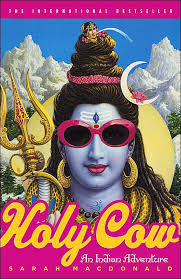by Vibha Sharma
If there is one place on the face of earth where all dreams of living men have found home from the very earliest days when man began the dream of existence, it is India – Romain Rolland
India is not, as people keep calling it, an underdeveloped country, but rather, in the context of its history and cultural heritage, a highly developed one in an advanced state of decay – Shashi Tharoor
India is perhaps the only land that actually lives up to the definition of mysticism in its entirety. This is the only place where if one thing exists, in all probability the exact opposite of the same thing also exists. Snake charmers and Ambanis, Bollywood glitterati and abject poverty, steadfast faith and extreme irreverence – all have the same country to name their own.
Being Indians, we have seen such huge diversity right from the moment we open our eyes that we have always considered it as part of who we are without consciously registering as much. But if we actually watch India from afar, she is too intriguing, overwhelming and awe-inspiring and has been a complex topic for many people. The fact is, India is beyond all definitions and statements and that is precisely the uniqueness of this country.
Many foreign pens and lenses have tried to capture the essence of Indian-ness in their words or in their pictures since times immemorial. Here, I pick five books to see how foreign authors have tried to present their interpretation of India to the outside world. A special tribute to William Dalrymple as three of his books make this list. He is one author who has explored India, studied India and has decided to make India his home.
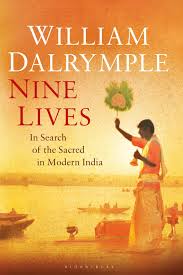 William Dalrymple is an accomplished historian and a fine narrator who spent 25 years travelling long and far from Rajasthan to Calcutta and from Bihar to Kerala. He rightly points out that even though most parts of India are aggressively running forward in every field keeping pace with the rest of the world there are some parts which are still deceptively innocent and timeless. He picks up nine stories of faith, conviction and reliance in response to individual spiritual calling in his travelogue Nine Lives. Through these lives the world is made acquainted to parts of India which for many did not exist or could not exist.
William Dalrymple is an accomplished historian and a fine narrator who spent 25 years travelling long and far from Rajasthan to Calcutta and from Bihar to Kerala. He rightly points out that even though most parts of India are aggressively running forward in every field keeping pace with the rest of the world there are some parts which are still deceptively innocent and timeless. He picks up nine stories of faith, conviction and reliance in response to individual spiritual calling in his travelogue Nine Lives. Through these lives the world is made acquainted to parts of India which for many did not exist or could not exist.
The tales are diverse. One is of a Jain nun who tries hard to come out of the shackles of attachment. She is committed to tread the ultimate detachment path which begins by first giving up home, then worldly possessions and finally the body itself. Another is of a prison warden, who feels proud to be a Thyyam dancer for two months in a year and keeps looking forward to these two months the rest of the year. During those Thyyam dance performances people take him to be an incarnate of deity and worship him. Then there are the daughters of Goddess Yellamma, called Devdasis, who think they are only destined to be temple prostitutes. Dalrymple tells the story of one such Devdasi who was forcibly pushed into this profession but who is now doing the same to her daughters, as she feels it is the call of their sacred faith. A Tibetan Buddist monk, who very early in his life saw the true purpose of his life and left everything behind to follow his faith, takes up arms during the Chinese invasion in Tibet despite having committed to follow the path of non-violence as preached by Buddha. Having opted for exile in India, he prays and hopes to breathe his last in his free homeland. A woman after having left her family in Calcutta in search of the divine goddess – Tara, now lives as a Tantric in a remote cremation ground. She finds the love and satisfaction of her life in one of the most unexpected places of all.
City of Djinns is Dalrymple’s tribute to the fascinating city Dilli or Delhi, which has innumerable stories buried deep in the folds 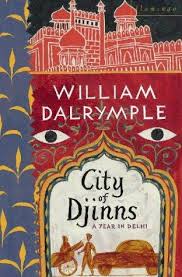 of the centuries that it has stood witness to. Readers are taken on a retro journey to find the roots of the city which is believed to have been established by Pandava brothers as Indraprastha, post the Kurukshetra battle. Since that time, the city has witnessed much, endured much, has lost much and transformed a lot. This is one city which has displayed unmatched resilience, as beautifully worded by the author here: “Though it had been burned by invaders time and time again, millennium after millennium, still the city was rebuilt, each time it rose like a phoenix from the fire.” The city which bore testimony to the zenith and nadir of great dynasties has a lot to tell about his past. Readers of this book would surely fall in love with two things – Dalrymple’s writing and the city of Delhi.
of the centuries that it has stood witness to. Readers are taken on a retro journey to find the roots of the city which is believed to have been established by Pandava brothers as Indraprastha, post the Kurukshetra battle. Since that time, the city has witnessed much, endured much, has lost much and transformed a lot. This is one city which has displayed unmatched resilience, as beautifully worded by the author here: “Though it had been burned by invaders time and time again, millennium after millennium, still the city was rebuilt, each time it rose like a phoenix from the fire.” The city which bore testimony to the zenith and nadir of great dynasties has a lot to tell about his past. Readers of this book would surely fall in love with two things – Dalrymple’s writing and the city of Delhi.
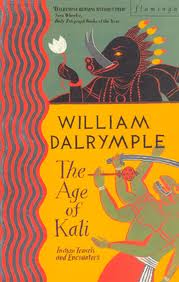
In The Age of Kali, William Dalrymple brings out the diversity in the faiths and beliefs of people. India is the land where various extremes coexist comfortably. Beauty is celebrated in the form of Khajuraho figurines, ‘Sati Mata’ is still revered in some parts, Shivalinga is one of the most sacred symbols in the temples and widows are left begging in the streets of Vrindavan. Every essay brings out the uniqueness of each grain of this vast nation. Besides this, he also opens a small window to peek inside the world of glamour and fame – the planet Bollywood. There are some essays on places like Lucknow, which bloomed culturally under the reigns of Mughal emperors and Nawabs, who were great connoisseurs of poetry, dances, books and numerous art forms, but which are now completely bankrupt after having endured the plunder by the British during its long rule and by corrupt politicians and mafia post independence. He then talks about the ‘Silicon Valley of India’ which symbolises how Indians are competing against the rest of the world in technology and many other spheres.
Twenty-one–year-old Sarah MacDonald visits India and to say the least she hates her experience in the country and vows never to step her foot on this land again. But destiny brings her back after 11 years. This time she comes to India leaving her dream job in Sydney for the love of her life, who happens to be posted in New Delhi at that time. Holy Cow is chronicle of her tryst with India the second time around.
Claiming to be an atheist, she finds herself in a totally alien territory where faith, belief and religion define a huge part of who people are. She embarks on a journey to unravel the mysteries of India and goes along as each day unfolds before her. To immerse herself deeply and to partake in all flavours, she first takes the calming Vipasana course in the small town of Dharamkot, pays a visit to the Vatican of Sikhs – the Golden Temple, travels to Kashmir and closely observes the Muslims and their ability to surrender and sacrifice. She spends some days in the Buddhist monastery at Dharamshala, marvels at the unbelievable simplicity and self-perfection of the Jain faith, gets awed by the orderly organisation of the Sathya Sai Baba ashram in Bangalore, appreciates Hinduism for showing innumerable ways to reach the divine and peeks into the lives of Indian Christians. After having gone through all her sojourns, she realises that she has actually made a start along the path to personal transformation and inner peace. While leaving India this time, she is glad “to be reborn as a better person, less reliant on others for her happiness and full of a desire to replace anger with love.”
India Rising is Oliver Balch’s tribute to the surging India which dwells in the high rises of metros and also in cramped 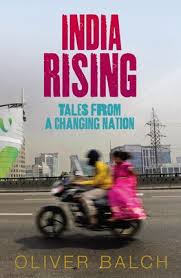 houses and narrow streets of shanty towns. The largest democracy is awakening from its slumber and has fastened its pace now. After having travelled extensively through the length and breadth of the country, Balch paints a picture of a nation which is at the crossroads now. He follows the dreams and ambitions of Dr. Devi Shetty, Captain Gopinath, Naveen Tewari and their likes. Dr. Shetty works towards the goal of ‘disassociating healthcare from affluence’, while Captain Gopinath made air travel a reality for the middle class and Naveen Tewari dared to work on his big idea and founded InMobi to sell ads for Internet-enabled phones. Balch also follows the story of Mohammad ‘Babu’ Sheikh, a Mumbai driver whose family migrated from Karnataka in the hope of better life and prospects.
houses and narrow streets of shanty towns. The largest democracy is awakening from its slumber and has fastened its pace now. After having travelled extensively through the length and breadth of the country, Balch paints a picture of a nation which is at the crossroads now. He follows the dreams and ambitions of Dr. Devi Shetty, Captain Gopinath, Naveen Tewari and their likes. Dr. Shetty works towards the goal of ‘disassociating healthcare from affluence’, while Captain Gopinath made air travel a reality for the middle class and Naveen Tewari dared to work on his big idea and founded InMobi to sell ads for Internet-enabled phones. Balch also follows the story of Mohammad ‘Babu’ Sheikh, a Mumbai driver whose family migrated from Karnataka in the hope of better life and prospects.
India Rising is Oliver Balch’s tribute to the surging India which dwells in the high rises of metros and also in cramped houses and narrow streets of shanty towns. He observes that Indians work hard to make progress from where they are, whether it is an IT employee or a driver in Mumbai. He tries to capture the view from the eyes of people belonging to diverse backgrounds and strata. The author specifies in his introduction: “My overarching goal is a flavour of this place, New India”, and he attempts to do that by listening to varied voices and their stories. The book is a commentary on how new opportunities are knocking at the doors of this country and how using these, people are trying to turn their dreams to reality.
The unique reporting in ‘Nine Lives’, ‘Age of Kali’, ‘City of Djinns’, ‘Holy Cow’ and ‘India Rising’ are undoubtedly brilliant attempts of accomplished writers, but the truth is, India is much beyond the realms of any words, phrases or compositions.
Vibha Sharma regularly reviews books in her blog http://literarysojourn.blogspot.com/

